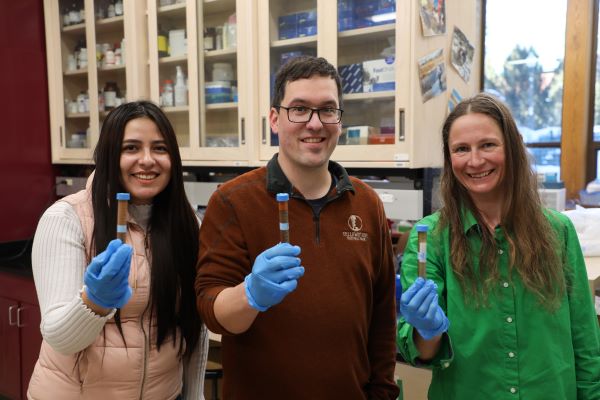Montana Tech researchers explore early Earth analogs in new Nature Communications article

Researchers with Montana Technological University’s Laboratory Exploring Geobiochemical Engineering and Natural Dynamics (LEGEND) have released a new article in the peer-reviewed, multidisciplinary, scientific journal Nature Communications, featuring hot springs in Yellowstone National Park.
The article may offer new insight into how life could have evolved on Earth.
“Co-variation of hot springs geochemistry with microbial genomic diversity, function, and evolution,” was published Aug. 29 and presents data from 1022 metagenome-assembles genomes (MAGs) that were collected from 34 high-temperature chemosynthetic hot springs in Yellowstone National Park.
Associate Professor of Environmental Chemistry Dr. Alysia Cox has been conducting research on the geochemistry of Yellowstone National Park’s thermal features since she was an undergraduate researcher in 2003, and explains there are three types of hot springs. Grand Prismatic and Old Faithful are alkaline chloride springs with water sources deep below the surface. The numerous mudpots and Mud Volcano are acidic sulfate springs, with shallow water sources. The third type of springs are mixed springs, with a pH of 4 to 6, which has a mix of deep and shallow water sources, along with other sources like precipitation.
Cox’s team and researchers from Montana State University worked collaboratively together to sample the springs and analyze the geochemical and metagenome data. Metagenomes are the complete set of genetic material from a group of microorganisms found in an environment. The research uncovered something unexpected. The microbial genomes found in the mixed springs had a shorter phylogenetic distance to root than those of the alkaline sulfate springs, meaning they contained more deeply branching taxa than those in the acid sulfate springs.
“What this is showing us is that the acid sulfate springs, which are formed by steam separation and oxidation of hydrogen sulfide to sulfuric acid, they're ‘evolutionarily younger’,” Cox said. “They're further from the root. They're not as deeply branching. There are hypotheses about the origin of life, looking at where life comes from, and some scientists hypothesize it's alkaline. But what we pointed out here, and I don't think this is the full story yet, but it's what we do mention in this paper, is that if you're looking for the origin of life or microbes that are deeply branching, you would actually look in these mixed springs.”
Associate Professor of Analytical Chemistry Dr. Brian St. Clair explained why Yellowstone National Park’s hot springs are a great place to study how life could have developed millions of years ago.
“It's ultimately oxygen that was the main driver for the population in those systems,” St. Clair said. “One of the overarching goals of this project is to look at how these microbial lineages might have existed as a function of Earth history. So, going back in time, before the Cambrian explosion 500 million years ago, there was just trace oxygen present on the Earth. The microbes that we found in these systems sort of correspond to the lineages, correspond to the amount of oxygen that is readily available. And so they've been constantly, of course, evolving in place. But they look like the sorts of lineages we would expect to find on an earlier type system.”
The samples were collected from Yellowstone National Park in 2020. In 2022, members of the research team traveled to Iceland to see if metagenome data collected from hot springs there might align with the insight gathered from the Yellowstone research. Eva Andrade-Barahona, an Earth Science and Engineering Ph.D. student from Ecuador, collected specimens in both Iceland and Yellowstone National Park, though her main task was analyzing the collected samples. She said the differences of the environmental conditions of the hot springs in the U.S. versus those in Iceland were significant. In Yellowstone, the team has a special scientific research permit to sample springs in protected hydrothermal areas off-limits to the general public.
“I have never seen nature that pristine,” Andrade-Barahona said.
By contrast, the samples collected in Iceland were much more accessible.
“There was one site that we kind of had to hike a little bit,” Andrade-Barahona said. “It was really cold and windy. But the rest of the other sites were part of the touristy places. It was less hard to access those places.”
Andrade-Barahona is a co-author on the paper, along with Montana Tech alumna Emilia Arteaga-Pozo (M.S. Geoscience- Geochemistry, 2022) whose MS thesis detailed the geochemistry of these Yellowstone and Icelandic hot springs.
Andrade-Barahona says that while her coursework has been instrumental in growing as a scientist, the hands-on work she’s done in the lab, analyzing samples for LEGEND has helped her even more.
“I have learned the most in the lab because we do the pre-sampling, we learn how to prepare the kits, how to take the samples, how to analyze them, how to look for funding for buying the stuff that is necessary, and how to assess problems,” Andrade-Barahona said.
The article was co-authored with researchers Dr. Daniel Colman, Ph.D. candidate Lisa Keller, Ph.D. candidate Anna Shoemaker and Dr. Eric Boyd at Montana State University,
To read the article Nature Communications article, click here.